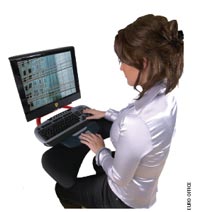Click Away the Pain
The age of computers has left many painfully bent out of joint, but a new device is designed to bring us back into alignment.
- By Marc Barrera
- May 01, 2008
 I don’t know how I lived without the scroll wheel on my
computer mouse. In this day and age of never having
enough time for anything, this one tiny item allows me to
quickly scroll through a document or a Web
page at blazing speeds as my ADHD demands
more and more.
I don’t know how I lived without the scroll wheel on my
computer mouse. In this day and age of never having
enough time for anything, this one tiny item allows me to
quickly scroll through a document or a Web
page at blazing speeds as my ADHD demands
more and more.
With that in mind, when I first received the center-
pointing Trackbar EmotionTM,my eyes were immediately
drawn to the scroll wheel at its center,
which was noticeably larger. The easiest way to compare
the two would be to say that if the former were
the wheel on a sports car, the latter would belong to
a monster truck. Directly above the wheel was a silver
scrolling “taskbar,” a device roughly 4 to 5 inches
long that scrolls up and down and moves to the left
and right, allowing for 360 degrees of movement.
On the bottom half of the device rests a set of four
large, silver buttons. The top two buttons work as
the right and left click features on a traditional
mouse and the bottom two function as forward and
back navigation buttons, which are pretty useful when Web surfing.
All of the buttons can be reprogrammed to fit users’ needs.
The science behind this device is quite simple. Centering it in
front of their keyboards allows users to keep their hands together in
a more natural position—as opposed to the outstretched arm position
of a traditional computer mouse—thereby keeping their bodies
symmetrically aligned toward the computer and reducing the
amount of movement and tension experienced during use.Whether
you call it Carpal Tunnel Syndrome, Repetitive Stress Syndrome, or
the European term “Mouse Arm Syndrome,” all of these occurrences
cause varying degrees of pain and numbness in the fingertips,
hands, arms, and shoulders, which can be greatly relieved or eliminated
by reducing the amount of movement necessary.
Putting It to the Test
I made a concerted effort to use this device for one month, during
which I intentionally kept my regular mouse connected in
order to gauge whether the Trackbar Emotion’s ease of use was
able to curb my tendency to switch back to mousing as usual. I
marveled at how easy it is to navigate the pointer with the
taskbar, which seemed extremely responsive to the slightest
movement.Mike Sjöblom, president of the Sweden-born Euro
Office, which makes the device, said this is because it employs
more than twice the sensor power of a traditional computer
mouse. “We have two optical sensors, each 1,000 dpi—which you
can relate with a traditional mouse, which usually has only one
optical sensor with 800 dpi,” he said.
It sounded great. But when it came time to click onto something,
I found I was all thumbs. I’m not used to clicking with my
thumbs, and although you can click down on the scroll bar with
your index fingers for a double click, in the process of pushing it
down it always seemed to roll a little in one direction or another,
moving the pointer away from my intended target. This doubleclick
function can be turned off by holding down the two lower
buttons and the taskbar at the same time for three seconds, but it
didn’t address my clicking problem. The answer came in the form
of a little gray button underneath the device. Should users decide
they prefer to use the device upside-down, with the
buttons on the top, controlled by their index fingers,
and the taskbar at the bottom, navigated by their
thumbs, they need only to press the button once and
all controls are reversed 180 degrees. This configuration
seemed more natural to me as my thumbs
found it easier to navigate the taskbar while my
index fingers clicked away.
An extra feature on the device is a microphone,
which is intended to allow users to employ voice
commands through the use of the latest computer
operating systems’ voice recognition engines. “What
we did was to back that up with a high-quality microphone
into the mouse, so now you can actually
replace mouse clicks with voice commands,” said
Sjöblom, adding that this also reduces the number
of user clicks, lessening the chance of an injury.
“What we base everything on is as little interaction [as possible]
between people and the machines. Therefore, you
don’t expose yourself to injuries.”
The Verdict
After one
month, I
found myself
using the
device merely
as a wrist rest
while typing,
deferring to the
ease of use and
speed of my traditional
scroll wheel
mouse when deadlines
loomed. That is
not to say the device is
not without its merits or
isn’t worth its hefty $99
price tag. Those suffering
with pain would probably
be more willing to take
the time to learn and customize their device for their particular
needs, eventually providing them the relief they seek and thus
making it a sound investment.
This article originally appeared in the June 2008 issue of Occupational Health & Safety.